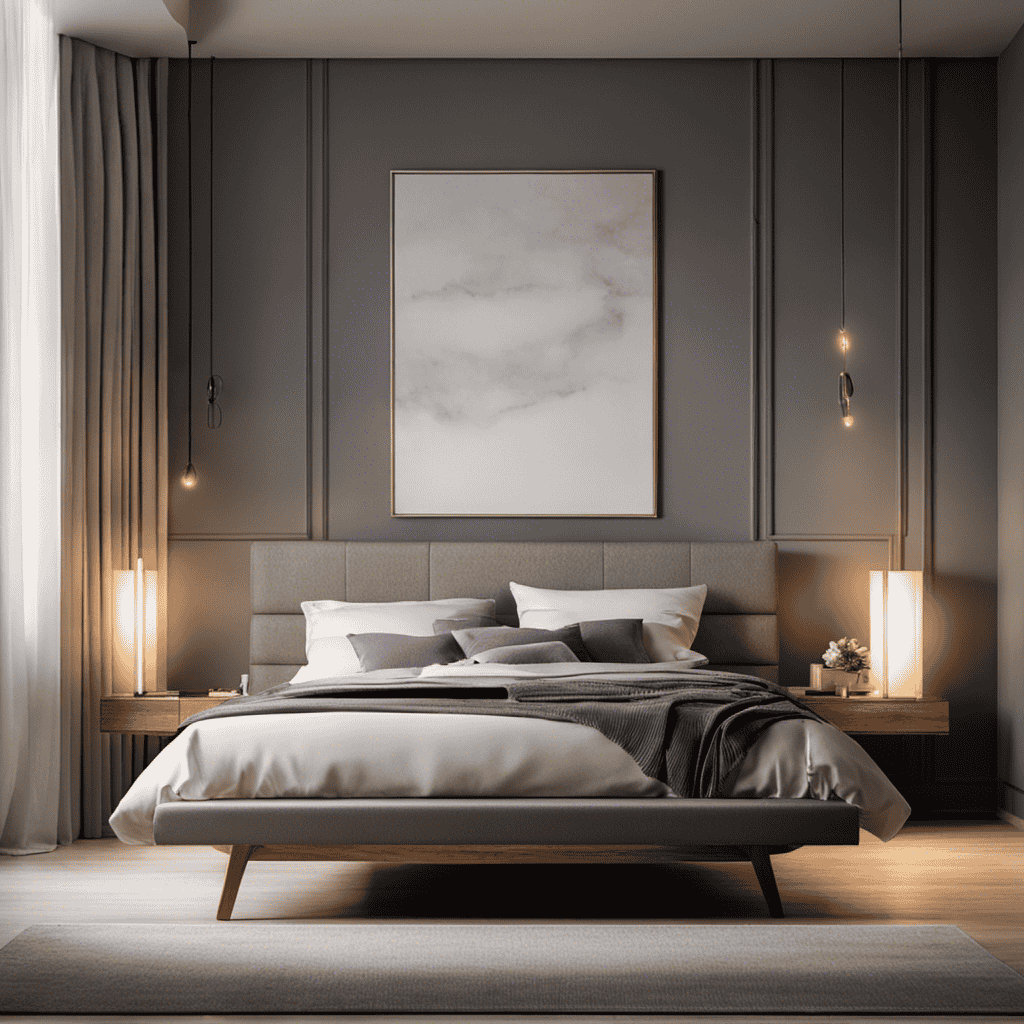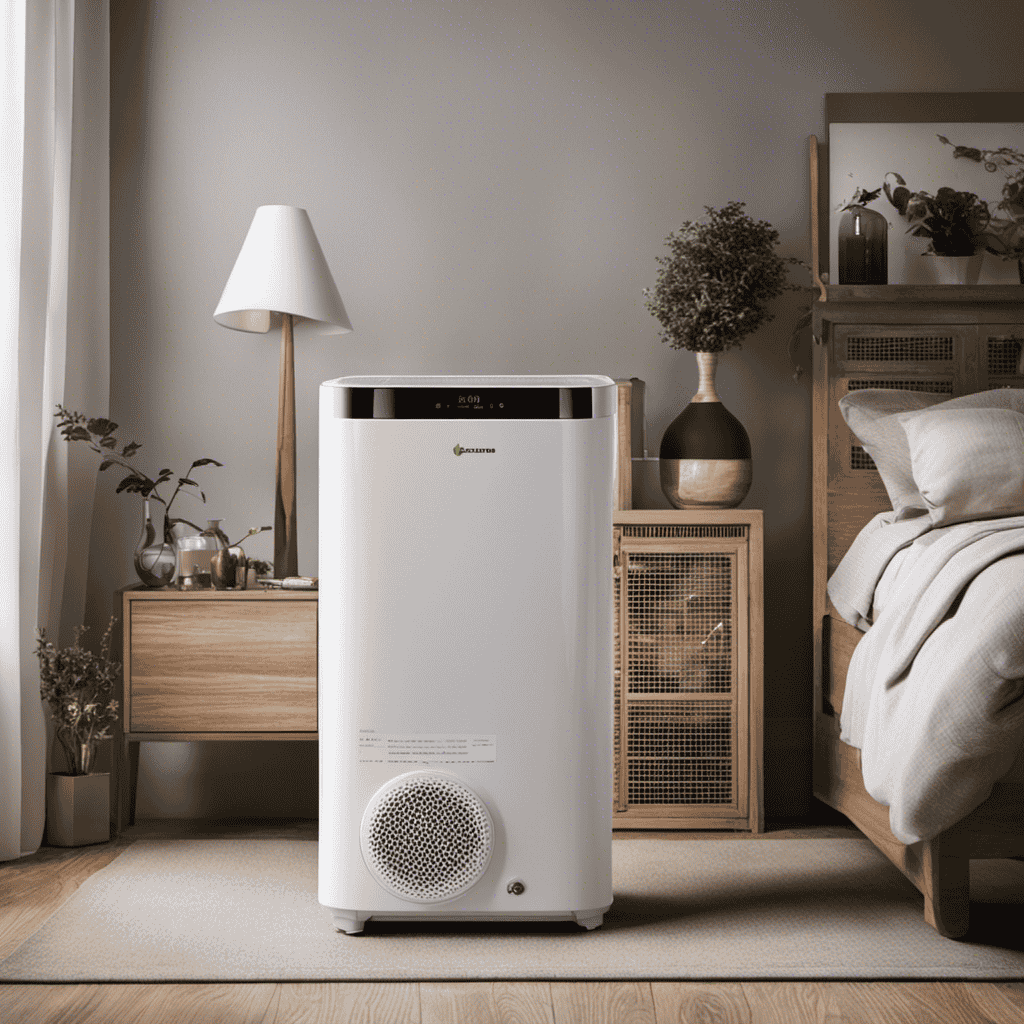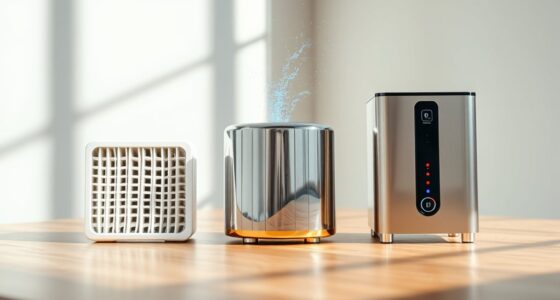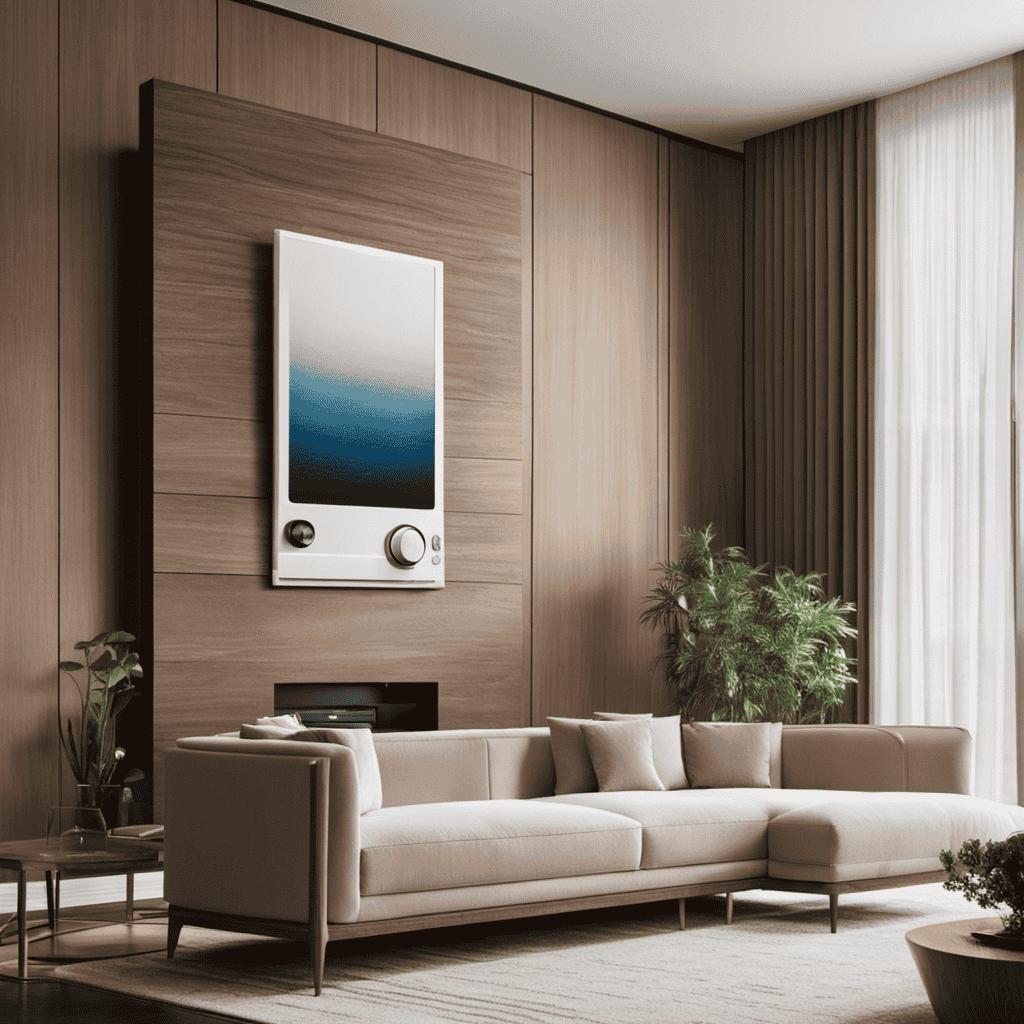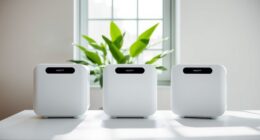I have frequently pondered about the timeframe for an air purifier to begin working effectively. Let me clarify that the answer is not as simple as one might assume.
Air purifiers come in all shapes and sizes, and their effectiveness can vary depending on a multitude of factors. In this article, we’ll dive into the world of air purification, exploring the processes, performance factors, and even the impact of room size.
So, if you’re as curious as I am, keep reading to discover the secrets behind optimal air purification time.
Key Takeaways
- Air purifiers use filters and various techniques to remove pollutants and improve air quality.
- The performance of an air purifier is influenced by factors such as room size, filter quality, and regular maintenance.
- Different air purifier technologies and filters have specific advantages and disadvantages, so it’s important to consider your specific needs.
- Maximizing the effectiveness of an air purifier involves proper filter maintenance, optimal placement, and minimizing other sources of pollution.
The Basics of Air Purifiers
If you’re wondering how air purifiers work, they use filters to remove pollutants and improve the air quality in your space. Understanding air quality is crucial because indoor air can be more polluted than outdoor air.
Pollutants such as dust, pollen, pet dander, and mold spores can cause allergies and respiratory issues. This is where air purifiers come in. By circulating the air through their filters, air purifiers trap and remove these pollutants, making the air cleaner and healthier to breathe.
The benefits of air purification are numerous. It can reduce asthma and allergy symptoms, improve sleep quality, and create a more comfortable living environment.
Now that we understand the basics of air purifiers and their benefits, let’s dive deeper into understanding air purification processes.
Understanding Air Purification Processes
Understanding how an air purifier functions is crucial in comprehending its effectiveness. Air purifiers use various techniques to remove pollutants and improve indoor air quality. These techniques include:
-
Filtration: Air purifiers use filters to trap airborne particles like dust, pollen, and pet dander. HEPA filters are especially effective at capturing small particles.
-
Activated Carbon: Some air purifiers incorporate activated carbon filters to absorb odors, smoke, and harmful volatile organic compounds (VOCs).
-
UV-C Light: Ultraviolet germicidal irradiation (UVGI) technology uses UV-C light to kill bacteria, viruses, and mold spores.
-
Ionization: Air purifiers with ionizers release negative ions into the air, which attach to airborne particles and cause them to fall to the ground.
-
Ozone Generation: Some air purifiers produce ozone, a highly reactive gas that can neutralize odors and kill certain bacteria and viruses.
By utilizing these air purification techniques, air purifiers can provide numerous benefits, including:
- Removing allergens and irritants, promoting better respiratory health.
- Eliminating unpleasant odors, creating a fresher indoor environment.
- Reducing the risk of airborne infections.
- Creating a more comfortable living space.
- Improving overall well-being by providing clean and healthy air.
Understanding how air purifiers work and the benefits they offer can help individuals make informed decisions about their indoor air quality.
Factors Affecting Air Purifier Performance
To maximize the effectiveness of your air purifier, consider factors such as room size, filter quality, and maintenance frequency. These factors play a crucial role in determining the efficiency of your air purifier and its ability to remove airborne particles.
The size of the room is important because it determines the air volume that needs to be purified. A larger room may require a more powerful air purifier or multiple units to achieve optimal air quality.
Filter quality is another significant factor as it determines the level of pollutants that can be removed from the air. High-quality filters can capture smaller particles and trap more contaminants, resulting in cleaner air.
Additionally, regular maintenance, such as cleaning or replacing filters, is essential to ensure the air purifier operates efficiently. Neglecting maintenance can lead to decreased performance and compromised air quality.
Understanding these factors will help you make informed decisions to improve your air purifier’s performance and overall air quality.
Now, let’s delve into how air purifiers capture and remove airborne particles.
How Air Purifiers Capture and Remove Airborne Particles
Knowing how air purifiers capture and remove airborne particles can help you select the best unit for your needs. Air purifiers work by using a combination of different technologies to effectively trap and eliminate pollutants from the air. Here is a breakdown of how air purifiers capture and remove airborne particles:
-
Filtration: Air purifiers typically use filters to capture particles. HEPA filters are highly efficient in trapping microscopic particles such as dust, pollen, and pet dander.
-
Activated Carbon: Some air purifiers also incorporate activated carbon filters to remove odors, gases, and chemicals from the air.
-
Ionization: Ionizers release negatively charged ions that attach to airborne particles, causing them to become heavy and fall out of the air.
-
UV-C Light: UV-C light is used to kill bacteria and viruses by damaging their DNA structure.
-
Ozone: In some air purifiers, ozone generators are used to neutralize odors and kill certain types of bacteria and viruses.
Understanding how these technologies work can help you choose an air purifier that offers the right balance of efficiency and effectiveness for your specific needs.
The Importance of Proper Air Circulation
For optimal results, make sure you have proper air circulation in your space.
The role of air circulation in indoor air quality cannot be overstated. Proper airflow is essential for effective air purification.
When air circulates properly, it helps to remove pollutants, allergens, and contaminants from the indoor environment. Good air circulation ensures that the air is constantly being refreshed, reducing the concentration of harmful particles in the air.
Additionally, proper air flow helps to distribute purified air evenly throughout the space, ensuring that every corner is covered. This is especially important in larger areas or rooms with multiple occupants.
By promoting better air quality, proper air circulation improves overall health and well-being.
With that in mind, let’s now explore the role of filters in air purifiers.
The Role of Filters in Air Purifiers
Filters in air purifiers play a crucial role in removing pollutants and allergens from the air. Understanding filter efficiency is essential in ensuring the effectiveness of an air purifier. One key type of filter that is highly recommended is the HEPA (High Efficiency Particulate Air) filter.
Here are five reasons why HEPA filters are important in air purifiers:
- HEPA filters can capture particles as small as 0.3 microns, effectively removing common allergens like pollen, pet dander, and mold spores.
- They can also trap larger particles such as dust, smoke, and bacteria, improving the overall air quality.
- HEPA filters have a high filtration efficiency of 99.97%, meaning they can remove almost all airborne particles that pass through them.
- These filters help reduce the risk of respiratory issues, especially for individuals with allergies or asthma.
- HEPA filters are long-lasting and require minimal maintenance, making them a cost-effective solution for clean indoor air.
Different Types of Air Purifier Technologies
With various types of air purifier technologies available, you can choose the one that best suits your needs and preferences. Here is a comparison of different air purifier technologies:
| Technology | Pros | Cons |
|---|---|---|
| HEPA (High-Efficiency Particulate Air) Filters | Highly effective in removing small particles like dust, pollen, and pet dander | Not effective against odors, gases, or volatile organic compounds (VOCs) |
| Activated Carbon Filters | Excellent at removing odors, gases, and VOCs | Less effective in removing small particles |
| Ionic Air Purifiers | Can remove particles as small as 0.01 microns | Ozone emissions may be harmful to health |
| UV Germicidal Lamps | Effective in killing bacteria and viruses | Limited effectiveness against particles and odors |
Each technology has its advantages and disadvantages. HEPA filters are great for allergies, while activated carbon filters are ideal for eliminating odors. Ionic air purifiers can tackle tiny particles, but the ozone emissions can be a concern. UV germicidal lamps are effective against germs, but may not be as efficient in removing other pollutants. Consider your specific needs and make an informed decision based on the pros and cons of each technology.
What to Consider When Buying an Air Purifier
When considering buying an air purifier, there are several important factors to take into account. First and foremost, it is crucial to think about air purifier maintenance. Regular maintenance is essential for optimal performance and longevity of the device. This includes cleaning the filters, replacing them when necessary, and keeping the unit free from dust and debris.
Another important consideration is choosing the right filter for your needs. Different air purifiers use different types of filters, such as HEPA filters, activated carbon filters, or electrostatic filters. Understanding the specific pollutants you want to target, such as allergens, odors, or smoke, will help you select the appropriate filter type.
In addition, it is important to consider the size and coverage area of the air purifier. A larger room will require a more powerful unit to effectively clean the air. Noise levels and energy efficiency are also important factors to consider, as they can impact the overall usability and cost of running the device.
Overall, thorough research and consideration of these factors will ensure that you choose the right air purifier for your specific needs and maintain it properly for optimal performance.
Common Misconceptions About Air Purifiers
When it comes to air purifiers, there are several common misconceptions that need to be addressed.
First, many people believe that air purifiers provide instant purification, but the truth is that it takes time for the air to be effectively cleaned.
Second, there is a misconception that one size fits all when it comes to air purifiers, but in reality, the size and type of purifier needed depend on the specific pollutants present in the air.
Lastly, while air purifiers can eliminate many pollutants, it is important to note that they may not eliminate all pollutants, especially those that are extremely small or volatile.
Instant Air Purification
An air purifier can provide instant relief by removing pollutants from the air you breathe. When you turn on an air purifier, you can expect immediate results in terms of improved air quality.
Here are some key points to consider about instant air purification:
- The air purifier starts working as soon as it is turned on, capturing and trapping pollutants in its filters.
- The size and efficiency of the air purifier’s filters play a crucial role in how quickly it can purify the air.
- The type and concentration of pollutants in the air also impact the speed of purification.
- In general, smaller particles like dust and pollen can be filtered out more quickly than larger particles like pet dander or smoke.
- It’s important to note that while an air purifier provides instant purification, it may take some time to fully clean the air in a larger space.
Overall, an air purifier can deliver immediate results by purifying the air you breathe, providing you with cleaner and healthier indoor air.
One Size Fits All
If you want a solution that fits all your needs, consider the size of the room before purchasing. When it comes to air purifiers, one size does not necessarily fit all.
The size of the room plays a crucial role in determining the effectiveness of the purifier in providing instant purification and eliminating all pollutants. A larger room requires a more powerful purifier to ensure that all the air in the room is effectively purified. On the other hand, a smaller room may not require a purifier with high power.
By choosing the right size of the air purifier, you can ensure that it efficiently eliminates all pollutants from the air, providing you with clean and fresh air to breathe. With the proper size, the purifier can effectively remove allergens, dust, pet dander, smoke particles, and other harmful substances, creating a healthier environment for you and your loved ones.
In the next section, we will explore how air purifiers eliminate all pollutants and provide a comprehensive solution to improve indoor air quality.
Eliminates All Pollutants
To effectively eliminate all pollutants, choose the right size of air purifier for your room. The size of the air purifier plays a crucial role in its effectiveness in air quality improvement. Here are five important factors to consider when selecting the right size:
- Room size: Measure the square footage of your room to determine the appropriate purifier size.
- Clean air delivery rate (CADR): Look for a purifier with a CADR that matches the size of your room for instant purification.
- Filter type: Different pollutants require different filters, so choose a purifier with the appropriate filter for your specific needs.
- Noise level: Consider the noise level of the purifier, especially if you plan to use it in a bedroom or office.
- Energy efficiency: Look for an energy-efficient purifier to minimize electricity consumption and reduce environmental impact.
How Long Does It Take for an Air Purifier to Start Working
You’ll notice that an air purifier starts working within a few minutes of turning it on. The process of instant purification begins as soon as the air purifier is activated.
It works in real-time to remove pollutants from the air, providing you with clean and fresh air to breathe. The air purifier’s filtration system, consisting of various filters such as HEPA filters, activated carbon filters, and pre-filters, efficiently captures and traps airborne particles like dust, pollen, pet dander, and even harmful gases and odors.
These filters work together to ensure that the air you breathe is free from contaminants. The air purifier continuously monitors the air quality and adjusts its settings accordingly to maintain a healthy indoor environment.
With the ability to start working almost immediately, an air purifier is a reliable solution for improving the air quality in your home or office.
Factors That Influence the Speed of Air Purification
When considering factors that influence the speed of air purification, it’s important to take into account the size of the room and the level of pollution present. The size of the room directly affects the time it takes for an air purifier to clean the air thoroughly. A larger room will require more time to circulate and purify the air effectively.
Additionally, the level of pollution in the room plays a significant role in the speed of air purification. Here are some tips for faster air purification:
- Use an air purifier with a higher Clean Air Delivery Rate (CADR) for faster purification.
- Keep doors and windows closed to prevent outside pollutants from entering the room.
- Regularly clean and replace the air filters to maintain optimal performance.
- Place the air purifier in a central location to maximize air circulation.
- Minimize other sources of pollution, such as smoking or using chemical-based products.
The Impact of Room Size on Air Purification Time
In my previous subtopic, I discussed the various factors that influence the speed of air purification. Now, I will delve into the impact of room size on air purification time.
The size of the room plays a crucial role in determining the effectiveness of an air purifier. Larger rooms require air purifiers with higher airflow rates to effectively clean the air. If the air purifier’s airflow rate is not sufficient for the room size, it may take longer to achieve clean air.
Additionally, the layout and configuration of the room can affect the circulation of air and the efficiency of the air purifier. Understanding the room size and its impact on air purifier effectiveness is essential for choosing the right device for your space.
Transitioning into the next section, let’s now explore how to maximize the effectiveness of your air purifier.
How to Maximize the Effectiveness of Your Air Purifier
When it comes to maximizing the effectiveness of your air purifier, there are three key points to consider.
First, proper filter maintenance is crucial. You should regularly check and clean or replace the filters to ensure they are functioning at their best.
Second, optimal placement strategies are important. Place the air purifier in a location where it can effectively circulate clean air throughout the room.
Lastly, regular ventilation practices can greatly improve air quality. This includes opening windows and using exhaust fans to bring in fresh outdoor air and remove indoor pollutants.
Proper Filter Maintenance
To keep your air purifier working effectively, make sure you regularly change the filters. Filter replacement is a crucial aspect of maintaining the optimal performance of your air purifier. Over time, filters become clogged with dust, allergens, and other particles, reducing their efficiency. By replacing filters at the recommended intervals, you ensure that your air purifier continues to effectively remove pollutants from the air in your home.
Additionally, proper cleaning techniques can also help extend the life of your filters. Here are some cleaning techniques to consider:
- Vacuuming: Use a vacuum cleaner with a brush attachment to gently remove dust and debris from the surface of the filter.
- Washing: Some filters can be washed with water and mild detergent. Follow the manufacturer’s instructions for proper washing techniques.
- Air drying: After washing, allow the filter to air dry completely before reinstalling it in the air purifier.
Optimal Placement Strategies
Now that we have discussed the importance of proper filter maintenance, let’s move on to the next aspect of optimizing the performance of an air purifier: optimal placement strategies.
The position of an air purifier plays a crucial role in its effectiveness in cleaning the air. To ensure optimal positioning, it is recommended to place the air purifier in an area where there is good airflow optimization. This means avoiding placing it in a corner or against a wall, as this can restrict the airflow and limit its ability to circulate the purified air throughout the room.
Instead, position the air purifier in a central location that allows for unrestricted airflow and maximum coverage. By doing so, you can enhance the efficiency of the air purifier and achieve better air quality in your indoor environment.
With this in mind, let’s now dive into the next topic: regular ventilation practices.
Regular Ventilation Practices
For optimal indoor air quality, it is important to regularly open windows and doors to allow fresh air to circulate throughout your space. This simple practice can greatly improve the quality of the air you breathe by reducing the concentration of indoor pollutants.
In addition to regular ventilation, it is important to perform regular maintenance on your HVAC system to ensure it is functioning properly. This includes cleaning or replacing air filters, checking for leaks or blockages, and scheduling professional inspections.
By taking these steps, you can effectively improve indoor air quality and create a healthier living environment for you and your family. Remember, regular maintenance and ventilation are key in reducing indoor air pollutants and promoting a healthier indoor environment.
- Open windows and doors to allow fresh air in
- Perform regular maintenance on HVAC system
- Clean or replace air filters
- Check for leaks or blockages
- Schedule professional inspections
Signs That Your Air Purifier Is Working Properly
You’ll know your air purifier is working properly when you start noticing cleaner and fresher air in your home. But how can you be sure that your air purifier is doing its job effectively? Here are some signs that indicate your air purifier is functioning correctly:
| Signs of a Properly Working Air Purifier |
|---|
| Decreased presence of airborne particles |
| Improved indoor air quality |
| Reduction in unpleasant odors |
| Decreased allergy symptoms |
When your air purifier is working properly, it should effectively filter out airborne particles such as dust, pollen, and pet dander. This will result in a noticeable improvement in indoor air quality, with a reduction in allergens and a fresher atmosphere. Additionally, you’ll notice a decrease in unpleasant odors, as the air purifier removes airborne contaminants that can cause unwanted smells. If you experience these positive changes, it’s a good indication that your air purifier is functioning as it should.
Now that you know the signs of a properly working air purifier, let’s discuss how to maintain and clean your air purifier for optimal performance.
Maintaining and Cleaning Your Air Purifier for Optimal Performance
To keep your air purifier operating at its best, it’s important to regularly clean and maintain it. Proper maintenance ensures that the device functions efficiently and effectively in removing pollutants from the air.
Here are some key steps to maintaining and cleaning your air purifier:
- Clean or replace the filters regularly to prevent clogging and maintain optimal airflow.
- Wipe down the exterior of the purifier to remove dust and dirt buildup.
- Check the fan and motor for any signs of damage or malfunction.
- Inspect the air vents and ensure they are free from blockages.
- Regularly monitor the air quality indicators to troubleshoot any issues and ensure the purifier is working effectively.
By following these maintenance practices, you can maximize the efficiency of your air purifier and address any potential problems before they escalate.
What Factors Can Affect an Air Purifier’s Effectiveness and Time for It to Work?
When considering the air purifier effectiveness timeline, several factors can impact how quickly and efficiently it works. Room size, the level of air pollution, and the type of air purifier all play a role in determining its effectiveness and the time it takes to purify the air.
Frequently Asked Questions
Can an Air Purifier Remove All Types of Airborne Particles?
Yes, an air purifier can remove various types of airborne particles, including dust, pollen, pet dander, mold spores, and even some bacteria and viruses. Its effectiveness depends on factors like the purifier’s filtration system and the size of the particles.
How Often Should I Replace the Filters in My Air Purifier?
Replacing air purifier filters should be a priority. Neglecting to do so can compromise the efficiency of the device and hinder its ability to clean the air. Regular cleaning and timely replacement are crucial for optimal performance.
Can an Air Purifier Eliminate Odors From My Home?
An air purifier can effectively eliminate pet odors and reduce the presence of cigarette smoke in your home. It works by filtering the air and capturing particles that cause these odors.
Is It Necessary to Keep My Windows Closed When Using an Air Purifier?
It’s not necessary to keep windows closed while using an air purifier. The noise level of the purifier may vary, but it can provide numerous benefits when used at night, such as improved air quality and better sleep.
Can an Air Purifier Help With Allergies and Asthma Symptoms?
Using an air purifier can greatly alleviate allergies and asthma symptoms. The benefits of cleaner air are undeniable. However, to truly understand the effectiveness of air purifiers, we must delve into the scientific research.
Conclusion
In conclusion, it’s crucial to understand how long it takes for an air purifier to work for clean and healthy indoor air. Factors like filtration process, room size, and air circulation all play a significant role in performance.
One interesting statistic to consider is that, on average, it takes about 30 minutes to 2 hours for an air purifier to effectively clean the air in a standard-sized room.
By following proper maintenance and cleaning routines, you can maximize your air purifier’s effectiveness and enjoy improved air quality in your home.

